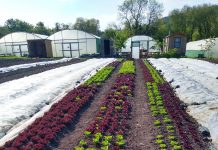Oh joy! Dancing around the Maypole at last! And the added happiness of transplanting our high summer fruiting crops—tomatoes, french and runner beans—and courgettes. The courgette is a beautiful plant, a dramatic size and shape with exotic leaves adding drama to the summer garden.
Sowing the courgette seed on its side helps avoid the seed rotting. Its top edge should be one seed’s width below the soil surface, as with most seeds. This is best done indoors for extra night-time warmth, and try to avoid planting outdoors before mid to late May. Often the slug gets the blame for killing your little plant, but it is usually because it is too cold, the plant is weak and susceptible. As always, fleece will help.
They are a greedy crop, needing at least a square yard each, lots of organic matter, and plenty of soil moisture. Pile lots of compost over the soil around the plant as a moisture mulch. The first fruit never grow large, so pick them small.
So long as they have plenty of moisture, food and warmth, they’ll do well. If growing in a pot, put plenty of seaweed feed in your water to keep them fruiting By August they sense the end of the year coming, and their leaves naturally begin to die back to let the sun in to ripen the fruits below. They get mildew and cause gardeners distress, but it’s quite natural, although keeping the soil well watered will help.
Defender and Black Beauty seem to be the best all round varieties, and keep fruiting into the autumn. The courgette is technically a Summer Squash, and you may like to play with the many exotic and novel varieties on offer. Every year we resolve to pick the fruits young, as they are definitely sweetest, but the plant’s own resolve to grow a huge marrow without you spotting it nearly always succeeds! And did you know there are only three types of people? Those who can count and those who can’t.
What to sow in May:
Virtually all summer crops can be sown this month, although it is risky to plant out heat lovers like French and runner beans until late in the month. Also winter cabbage, purple sprouting and second crops of lettuce and beetroot.








